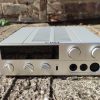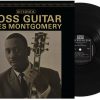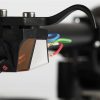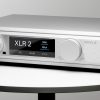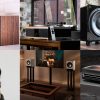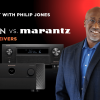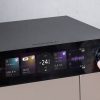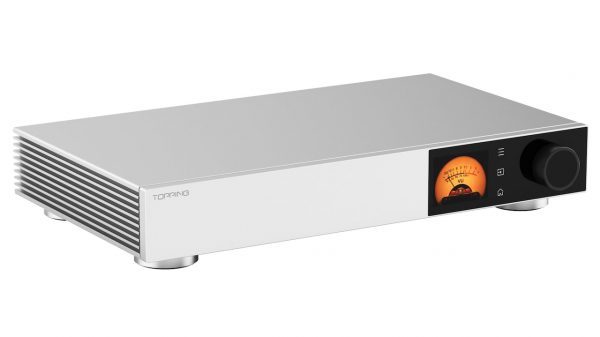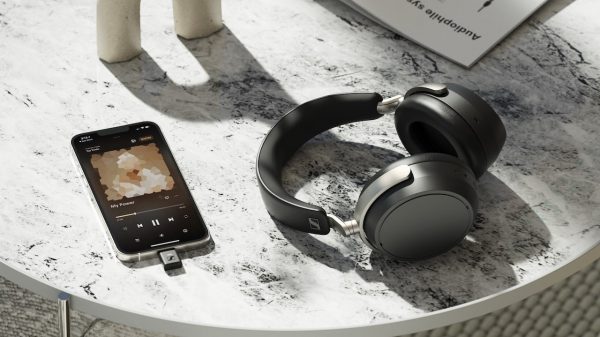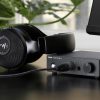The internet’s a junkyard of dopamine hits, outrage bait, and doomscrolls, hammering your attention like a drunk with a nail gun. Real detachment? Not a luxury—it’s survival. Music, books, movies—they don’t vanish with a swipe. They stick. They matter. And if your ears deserve more than earbuds swaddled in marketing fluff, a proper desktop headphone system—real circuitry, actual soul—will remind you what real listening feels like. The world’s a mess. Your desk doesn’t have to be.

Ownership matters because these aren’t just objects—they’re sparks. They nudge you, poke at your imagination, and sometimes jolt you hard enough to remind you there’s still a pulse.
The power of music to calm your nerves or drag your sorry mood out of a ditch isn’t new-age fluff—it’s neuroscience. And yes, we’re talking real mood rescue here—like when your Russian mail-order bride ghosts you for a guy she met on Hinge who owns three NFTs and still uses Axe body spray. This stuff works.
Mediocre sound isn’t just annoying—it’s an insult.

Desktop Headphone Audio in 2025: The Slow, Snarky Evolution You Didn’t See Coming
Modern tube amps aren’t the syrupy, rolled-off beasts they used to be. The best designs today aim for balance—less coloration, a little more honest at both frequency extremes—while still giving you that texture people chase tubes for. With tubes getting pricier, efficient circuits that squeeze the most out of them are becoming the rule, not the exception.
They deliver a sense of presence and realism that some solid-state amps struggle to replicate. And while some high-end models still carry luxury price tags, there’s now a growing range of well-built, great-sounding tube amps that offer excellent performance and value—making them an increasingly smart choice for listeners who want character without compromise.
In 2025, the DAC landscape has also shifted dramatically. Affordable desktop and dongle-style DACs now offer a level of performance, connectivity, and versatility that would’ve cost a small fortune just a few years ago.

With features like native DSD playback, 32-bit/384kHz PCM, balanced outputs, and multiple digital inputs becoming standard even under $200, many of today’s budget DACs outperform the “audiophile-grade” units of the past.
The value gap has widened to the point where many older, overpriced DACs feel outdated by comparison—lacking modern codec support, efficient power management, or mobile-friendly form factors. Simply put, great digital audio is more accessible than ever.
When Tariffs Crash the Party: The Quirky Crisis Facing Desktop Headphone Audio in 2025

The Head-Fi revolution has reshaped the headphone landscape, making high-quality sound more accessible than ever. Whether you’re spending $150 or $5,000, there are options that rival what was once reserved for the audiophile elite. From planar-magnetic headphones and open-back designs to hybrid IEMs and studio monitors, there’s something at every price point offering clarity, detail, and presence.
Brands like HiFiMAN, Moondrop, SMSL, Topping, WiiM, FiiO, Schiit Audio, Questyle, Meze, and iFi have led a quiet revolution—delivering audiophile-grade performance at prices that would’ve been laughed out of the room a decade ago. They’ve made it possible for everyday listeners to build systems that rival setups once reserved for hedge fund managers and recording studios.
But here’s the catch: this golden age of affordable high-end sound may not last—or offer the same level of value that it has for the past few years.

Thanks to the tariff war between the U.S. and almost everybody—and the recent death of the de minimis exemption—getting your hands on an affordable DAC, headphone amp, or IEM from across the Pacific is about to cost you more than just your lunch money.
Why Build a Desktop System?
There are brands offering performance and value without the sky-high price tags. With the right mix of tube amps, DACs, and headphones, you can build a desktop system that delivers serious sound—no need to sell your ship for some peace in a world that’s a little off right now.
Desktop systems aren’t just for show—they bring the power, clarity, and connectivity that pocket-sized gear can only dream of. They’ll drive anything from 600 ohm relics to power-hungry planars without breaking a sweat, and they usually sound better doing it. You also get real inputs and outputs (imagine that!), not just a lonely USB-C. Best part? You’ll finally stop pretending your phone dongle sounds “just as good.”
An inexpensive network streamer like the WiiM Pro Plus, or WiiM Ultra if you need the screen and a few extra bells, is the smart move here. These things are silent, compact, and way more reliable than a laptop clinging to life with 42 Chrome tabs open. Don’t overthink it—stream Qobuz or TIDAL straight to your DAC, skip the drama. Want to go even cheaper? Your smartphone is perfectly capable—as long as you don’t pair it with a sketchy dongle that came free with a phone case.
Use a proper USB-C to USB-B cable (or Lightning, if you’re living dangerously), plug it into a real DAC, and let it do what it was born to do: send bits. Just don’t expect bit-perfect playback if you’re running Spotify through a Bluetooth speaker you got at a conference in 2018.
Headphone Editor Will Jennings and I are cooking up Parts II and III of this list—coming later this month—and let’s just say we’ve got some rather unorthodox but seriously satisfying combinations headed your way. Think of this as the appetizer. It was a long, hot summer—the kind where Florida’s humidity feels like soup and Jersey’s electric bills spiked 28% just for existing. You’re killing me, Smalls.
The $600 Hi-Fi Hack: Topping and Sennheiser Prove You Don’t Need to Go Broke

DAC: Topping E30 II ($149)
Amp: Topping L30 II ($149)
Headphones: Drop x Sennheiser HD6xx ($299)
Cables/Misc: RCA interconnects included in the bundle (bless them)
Total: ~$597
Why it Works:
This is the kind of setup that makes you question why people drop four figures on gear just to listen to the same Radiohead album for the hundredth time. The Topping E30 II/L30 II stack is clean, clinical, and absurdly competent—measuring better than gear five times the price (if you care about that sort of thing). And the HD6xx? It’s the people’s headphone. Warm, smooth, and built for long listening sessions that spiral into 2AM Reddit threads about burn-in. You get real separation, proper dynamics, and enough headroom to make you forget your phone ever had a headphone jack. This stack doesn’t just work—it works too well for the money, and that’s the kind of crime we can all get behind.
Planar Power Play: A $1000 Stack That’ll Melt Your Brain, Not Your Wallet

DAC: HiFiMAN EF400 ($399 R2R Ladder DAC + Balanced Amp in one)
Amp: Built into the EF400 (don’t worry, it’s not an afterthought)
Headphones: HiFiMAN Ananda Stealth ($299 on sale like it owes someone money)
Cables/Misc: Balanced cable highly recommended ($18 sold separately, because of course it is)
Total: ~$716
Why it Works:
The EF400 isn’t just another pretty face with glowing LEDs—it’s packing HiFiMAN’s in-house Himalaya R2R DAC, a fully balanced FPGA design that’s more substance than marketing gimmick. This is the first time we’ve seen it properly let off the leash in a desktop unit, and it shows. Oversampling? You can kill it with a flick of the front-panel switch. Output? 4.4 watts balanced—enough to slap the HE6 into submission without flinching.
Internally, it’s Class A/B done right—clean, powerful, and free of the usual noise-floor baggage. You get proper 4.4mm and XLR balanced outs, plus SE for the stubborn. Paired with the Ananda Stealth’s speed and air, this is synergy you don’t need to squint at. It’s resolving, muscular, and musical—and unlike some overpriced snake oil rigs, this one actually shows its math. For under $900, it’s a surgical strike on the high-end market. Plug in, lean back, and don’t look up till November.
Studio Sniper or Sofa King Chill: The $2.1K Desktop That Does It All
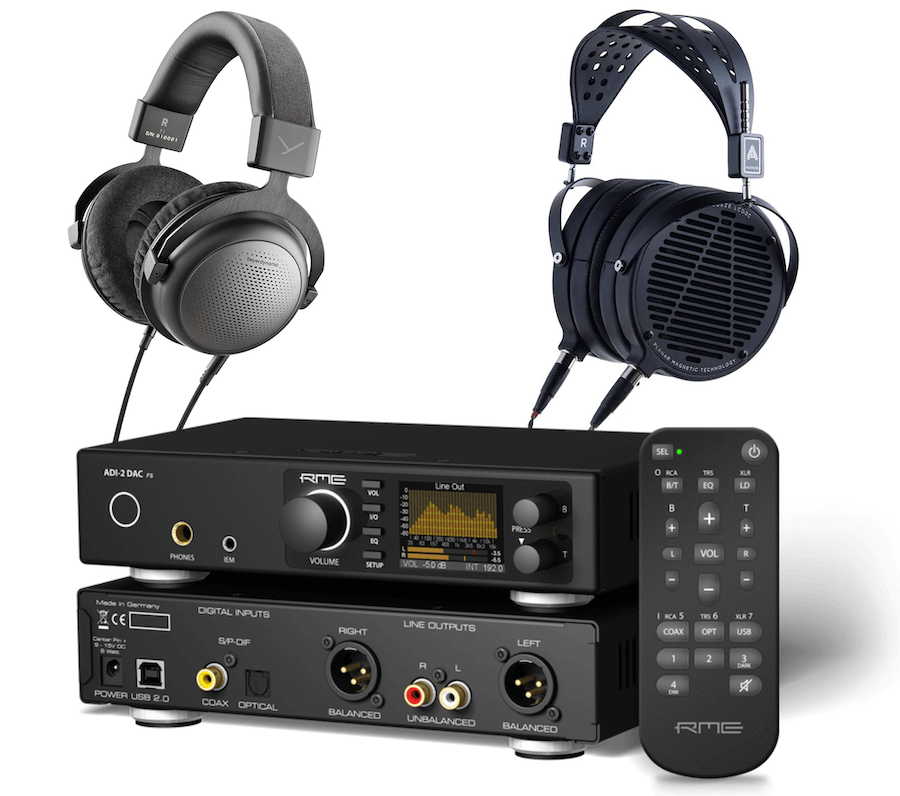
DAC: ADI-2 DAC FS ($1,299)
Amp: Built-in (and built like a damn scalpel)
Headphones:
- For critical listeners: Beyerdynamic T1 (3rd Gen, $799)
- For laid-back immersion: Audeze LCD-2 (Classic, $799)
Cables/Misc: RME includes everything but a therapist
Total: ~$2,098 depending on your flavor of sonic masochism
Why it Works:
The ADI-2 DAC FS is the audio equivalent of a German precision rifle—clinical, obsessive, and built to perform without flinching. RME took what made the ADI-2 Pro a studio legend and refined it: the new SteadyClock, optimized analog stage, updated MRC remote, Extreme Power headphone amp, and an absurdly quiet IEM output. Inside, the ESS ES9028Q2M runs in a custom RME circuit for peak performance, hitting 123 dBA SNR, -120 dB distortion, and a noise floor that practically disappears at -121 dBu.
Add +2.5 dB of digital headroom for intersample peaks, full DSP control (EQ, Loudness, Crossfeed, Bass/Treble), and the kind of transparency that borders on surgical. Whether you’re mastering or just listening critically, the ADI-2 DAC FS doesn’t color sound—it dissects it.
Pair it with the Beyerdynamic T1 for studio-grade neutrality and the kind of imaging that makes you hear ghosts—or go with the LCD-2 for a warm, rich listen that wraps around you like a weighted blanket after a long day of pretending to work. Either way, you’re getting elite fidelity, ironclad build quality, and an interface that doesn’t look like it was designed by a sadist. It’s not cheap—but it’s not stupid either. This rig does the job. All of them.
Related Reading:
- Rotel DX-3 Review: Heavyweight DAC & Headphone Amp That Doubles As A Flexible Preamp For Active Speakers
- The Best Desktop DACs And Headphone Amps From CanJam London 2025
- JDS Labs Element IV DAC/AMP Review
- HiFiMAN’s SERENADE Wireless DAC/Headphone Amplifier Supports Lossless Streaming For Less Money
- FiiO K15 DAC Headphone Amp: The Affordable Desktop Option Schiit Hopes You Ignore


